CO2 as an Alternative to Traditional Antiscalants in Pressure-Driven Membrane Processes: An Experimental Study of Lab-Scale Operation and Cleaning Strategies
Abstract
:1. Introduction
2. Materials and Methods
2.1. Membrane and Chemical Agents
2.2. Operation Strategy of the RO Systems
2.3. Instrumentation
3. Results and Discussion
3.1. Operational Performances of RO Units
3.2. Visual Examination of the Fouled RO Membranes
3.3. Membrane Surface Analysis
3.4. Evaluation of CP
4. Conclusions
Author Contributions
Funding
Institutional Review Board Statement
Data Availability Statement
Conflicts of Interest
References
- Shen, D. Climatic Change and Water Resources. In Water Resources Management of the People’s Republic of China; Shen, D., Ed.; Springer International Publishing: Cham, Switzerland, 2021; pp. 409–430. ISBN 978-3-030-61931-2. [Google Scholar]
- Ennaceri, H.; Fischer, K.; Schulze, A.; Moheimani, N.R. Membrane Fouling Control for Sustainable Microalgal Biodiesel Production: A Review. Renew. Sustain. Energy Rev. 2022, 161, 112335. [Google Scholar] [CrossRef]
- Kashif, A.; Rehman, R.; Fuwad, A.; Shahid, M.K.; Dayarathne, H.N.P.; Jamal, A.; Aftab, M.N.; Mainali, B.; Choi, Y. Current Advances in the Classification, Production, Properties and Applications of Microbial Biosurfactants—A Critical Review. Adv. Colloid Interface Sci. 2022, 306, 102718. [Google Scholar] [CrossRef] [PubMed]
- Chen, G.-Q.; Wu, Y.-H.; Fang, P.-S.; Bai, Y.; Chen, Z.; Xu, Y.-Q.; Wang, Y.-H.; Tong, X.; Luo, L.-W.; Wang, H.-B.; et al. Performance of Different Pretreatment Methods on Alleviating Reverse Osmosis Membrane Fouling Caused by Soluble Microbial Products. J. Memb. Sci. 2022, 641, 119850. [Google Scholar] [CrossRef]
- Shahid, M.K.; Pyo, M.; Choi, Y. Carbonate Scale Reduction in Reverse Osmosis Membrane by CO2 in Wastewater Reclamation. Membr. Water Treat. 2017, 8, 125–136. [Google Scholar] [CrossRef]
- Amiria, A.; Al-Rawajfehb, A.; Brewera, C.E. Simulation of Small-Scale Thermal Water Desalination Using Biomass Energy. Desalin. Water Treat. 2018, 108, 65–75. [Google Scholar] [CrossRef]
- Al-Maabreh, A.M.; Al-Rawajfeh, A.E.; Alshamaileh, E.; Al-Bazedi, G.A. Mitigation of Scale Problem in the Pumped Disi Water to Amman, Jordan. Environ. Prot. Eng. 2019, 45, 97–110. [Google Scholar] [CrossRef]
- Dayarathne, H.N.P.; Choi, J.; Jang, A. Enhancement of Cleaning-in-Place (CIP) of a Reverse Osmosis Desalination Process with Air Micro-Nano Bubbles. Desalination 2017, 422, 1–4. [Google Scholar] [CrossRef]
- Dayarathne, H.N.P.; Jeong, S.; Jang, A. Chemical-Free Scale Inhibition Method for Seawater Reverse Osmosis Membrane Process: Air Micro-Nano Bubbles. Desalination 2019, 461, 1–9. [Google Scholar] [CrossRef]
- Shirazi, S.; Lin, C.J.; Chen, D. Inorganic Fouling of Pressure-Driven Membrane Processes—A Critical Review. Desalination 2010, 250, 236–248. [Google Scholar] [CrossRef]
- Aslam, M.; Yang, P.; Lee, P.H.; Kim, J. Novel Staged Anaerobic Fluidized Bed Ceramic Membrane Bioreactor: Energy Reduction, Fouling Control and Microbial Characterization. J. Memb. Sci. 2018, 553, 200–208. [Google Scholar] [CrossRef]
- Chen, G.-Q.; Wu, Y.-H.; Tan, Y.-J.; Chen, Z.; Tong, X.; Bai, Y.; Luo, L.-W.; Wang, H.-B.; Xu, Y.-Q.; Zhang, Z.-W.; et al. Pretreatment for Alleviation of RO Membrane Fouling in Dyeing Wastewater Reclamation. Chemosphere 2022, 292, 133471. [Google Scholar] [CrossRef]
- Unal, B.O. Membrane Autopsy Study to Characterize Fouling Type of RO Membrane Used in an Industrial Zone Wastewater Reuse Plant. Desalination 2022, 529, 115648. [Google Scholar] [CrossRef]
- Rolf, J.; Cao, T.; Huang, X.; Boo, C.; Li, Q.; Elimelech, M. Inorganic Scaling in Membrane Desalination: Models, Mechanisms, and Characterization Methods. Environ. Sci. Technol. 2022, 56, 7484–7511. [Google Scholar] [CrossRef] [PubMed]
- Ngene, I.S.; Lammertink, R.G.H.; Kemperman, A.J.B.; Van De Ven, W.J.C.; Wessels, L.P.; Wessling, M.; Van Der Meer, W.G.J. CO2 Nucleation in Membrane Spacer Channels Remove Biofilms and Fouling Deposits. Ind. Eng. Chem. Res. 2010, 49, 10034–10039. [Google Scholar] [CrossRef]
- Shahid, M.K.; Choi, Y. Sustainable Membrane-Based Wastewater Reclamation Employing CO2 to Impede an Ionic Precipitation and Consequent Scale Progression onto the Membrane Surfaces. Membranes 2021, 11, 688. [Google Scholar] [CrossRef]
- Cai, Y.-H.; Galili, N.; Gelman, Y.; Herzberg, M.; Gilron, J. Evaluating the Impact of Pretreatment Processes on Fouling of Reverse Osmosis Membrane by Secondary Wastewater. J. Memb. Sci. 2021, 623, 119054. [Google Scholar] [CrossRef]
- Jung, O.; Saravia, F.; Wagner, M.; Heißler, S.; Horn, H. Quantifying Concentration Polarization—Raman Microspectroscopy for In-Situ Measurement in a Flat Sheet Cross-Flow Nanofiltration Membrane Unit. Sci. Rep. 2019, 9, 15885. [Google Scholar] [CrossRef]
- Rahardianto, A.; Gu, H.; Khan, B.M.; Plumlee, M.H. Real-Time Reverse Osmosis Monitoring for Antiscalant Dose Selection in Advanced Treatment of Wastewater. AWWA Water Sci. 2020, 2, e1196. [Google Scholar] [CrossRef]
- Shahid, M.K.; Choi, Y.-G. The Comparative Study for Scale Inhibition on Surface of RO Membranes in Wastewater Reclamation: CO2 Purging versus Three Different Antiscalants. J. Memb. Sci. 2017, 546, 61–69. [Google Scholar] [CrossRef]
- Alpatova, A.; Qamar, A.; Al-Ghamdi, M.; Lee, J.; Ghaffour, N. Effective Membrane Backwash with Carbon Dioxide under Severe Fouling and Operation Conditions. J. Memb. Sci. 2020, 611, 118290. [Google Scholar] [CrossRef]
- Shahid, M.K.; Pyo, M.; Choi, Y.-G. The Operation of Reverse Osmosis System with CO2 as a Scale Inhibitor: A Study on Operational Behavior and Membrane Morphology. Desalination 2017, 426, 11–20. [Google Scholar] [CrossRef]
- Vrouwenvelder, J.S.; Beyer, F.; Dahmani, K.; Hasan, N.; Galjaard, G.; Kruithof, J.C.; Loosdrecht, M.C.M. Van Phosphate Limitation to Control Biofouling. Water Res. 2010, 44, 3454–3466. [Google Scholar] [CrossRef]
- Cai, Y.-H.; Burkhardt, C.J.; Schäfer, A.I. Renewable Energy Powered Membrane Technology: Impact of Osmotic Backwash on Scaling during Solar Irradiance Fluctuation. J. Memb. Sci. 2021, 619, 118799. [Google Scholar] [CrossRef]
- Guillen-Burrieza, E.; Thomas, R.; Mansoor, B.; Johnson, D.; Hilal, N.; Arafat, H. Effect of Dry-out on the Fouling of PVDF and PTFE Membranes under Conditions Simulating Intermittent Seawater Membrane Distillation (SWMD). J. Memb. Sci. 2013, 438, 126–139. [Google Scholar] [CrossRef]
- Lin, D.; Bai, L.; Xu, D.; Zhang, H.; Guo, T.; Li, G.; Liang, H. Effects of Oxidation on Humic-Acid-Enhanced Gypsum Scaling in Different Nanofiltration Phases: Performance, Mechanisms and Prediction by Differential Log-Transformed Absorbance Spectroscopy. Water Res. 2021, 195, 116989. [Google Scholar] [CrossRef]
- Farhat, S.; Bali, M.; Kamel, F. Membrane Autopsy to Provide Solutions to Operational Problems of Jerba Brackish Water Desalination Plant. Desalination 2018, 445, 225–235. [Google Scholar] [CrossRef]
- Rathinam, K.; Modi, A.; Schwahn, D.; Oren, Y.; Kasher, R. Surface Grafting with Diverse Charged Chemical Groups Mitigates Calcium Phosphate Scaling on Reverse Osmosis Membranes during Municipal Wastewater Desalination. J. Memb. Sci. 2022, 647, 120310. [Google Scholar] [CrossRef]
- Wang, M.; Wang, J.; Jiang, J. Membrane Fouling: Microscopic Insights into the Effects of Surface Chemistry and Roughness. Adv. Theory Simul. 2022, 5, 2100395. [Google Scholar] [CrossRef]
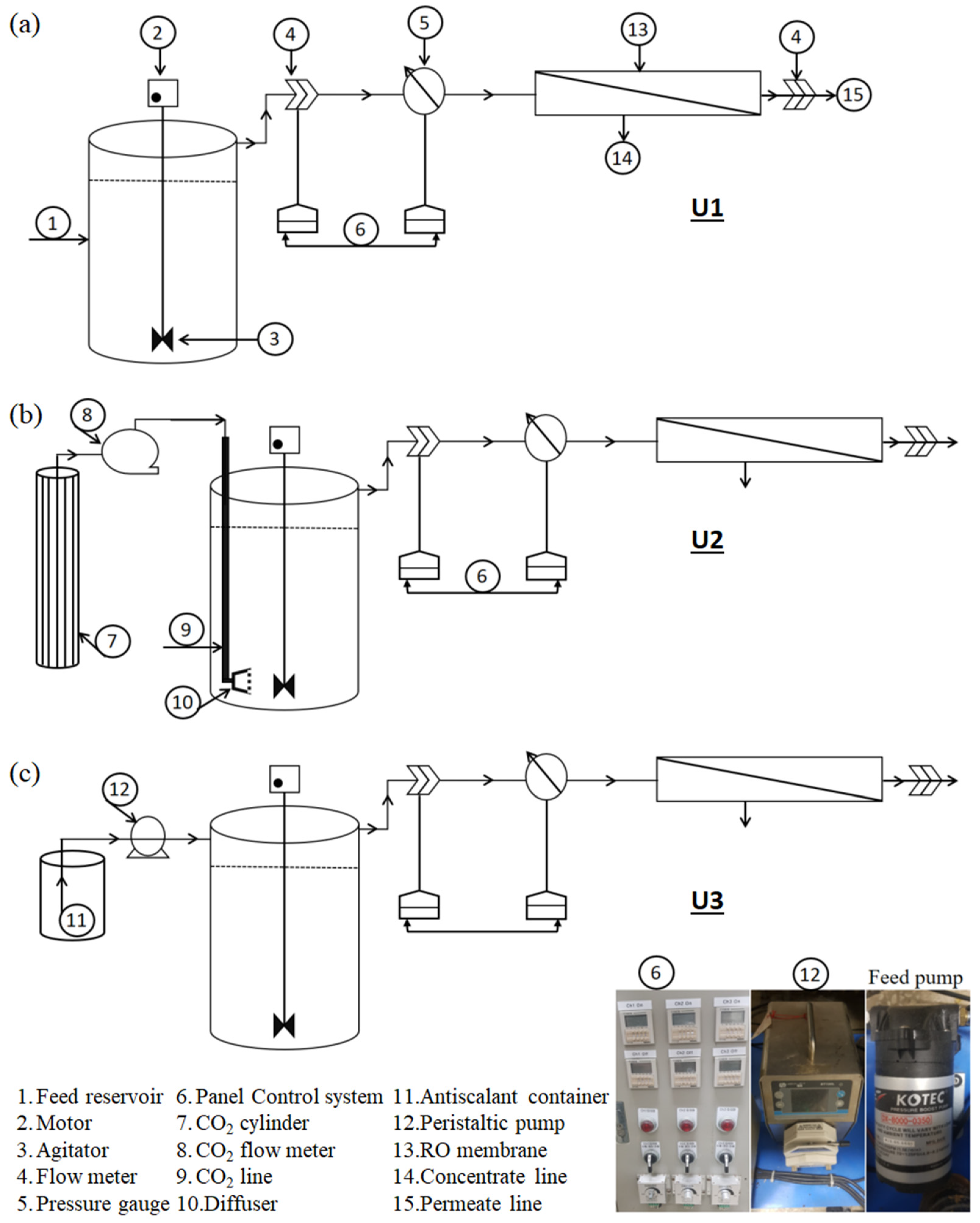
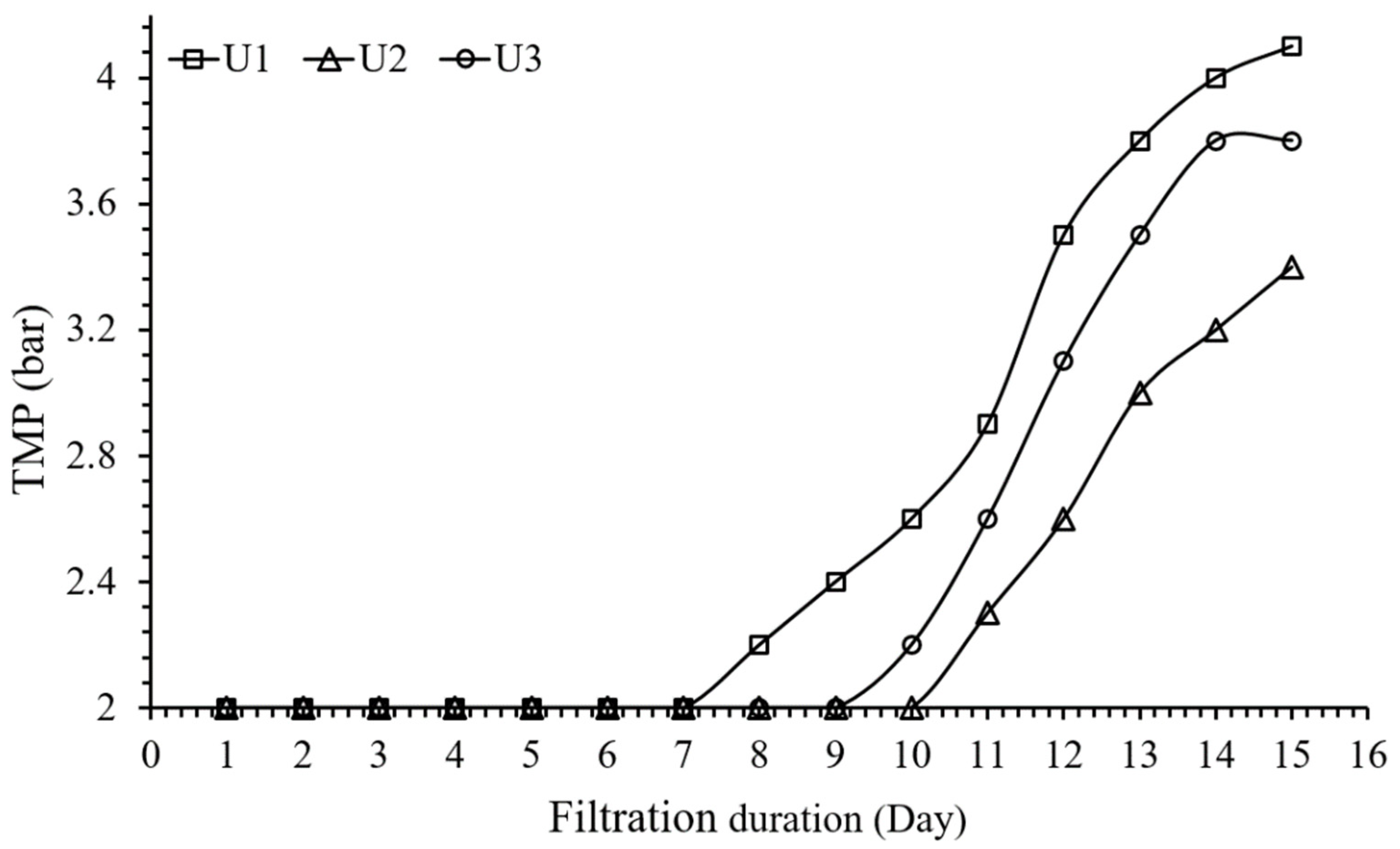

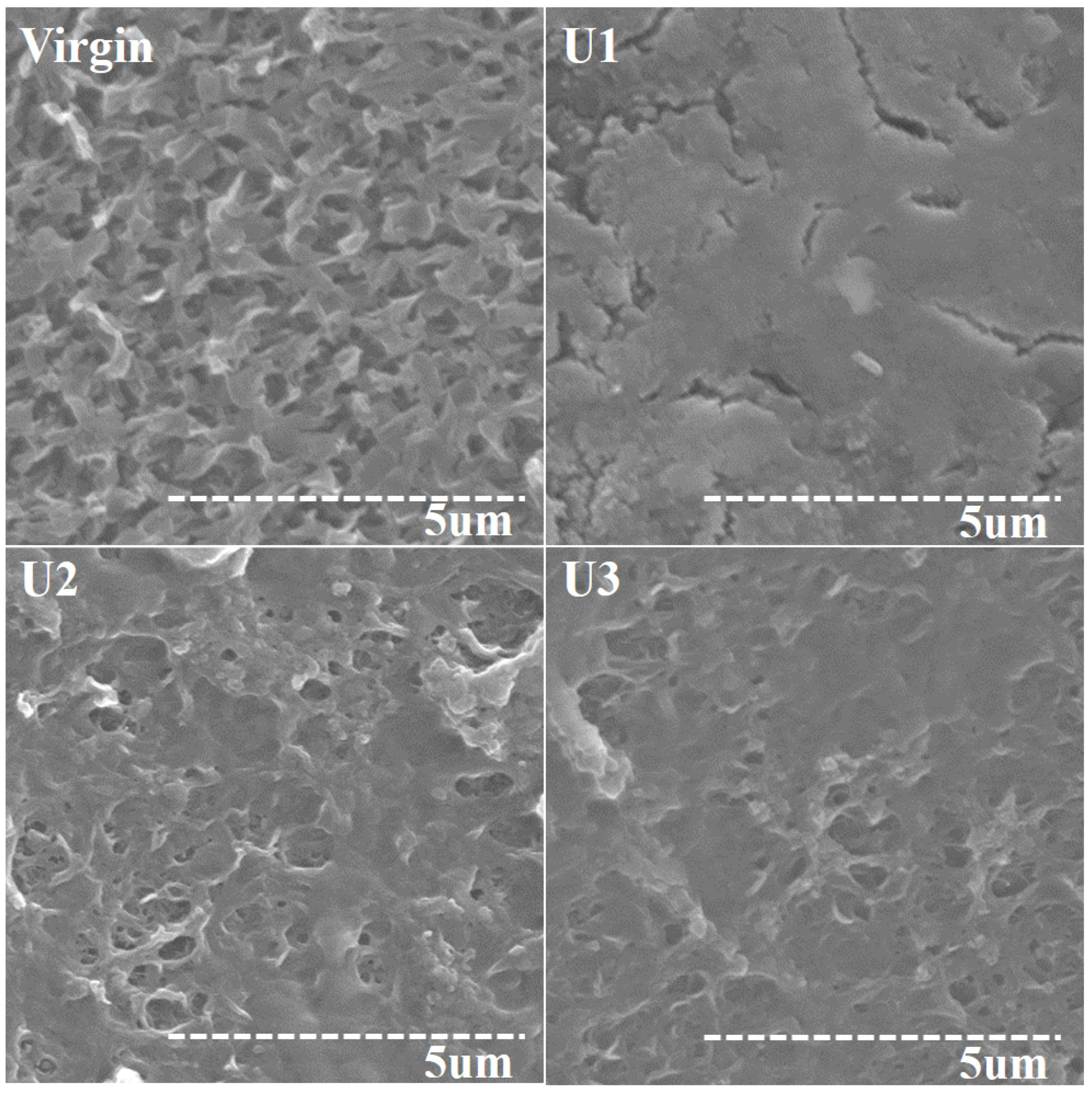

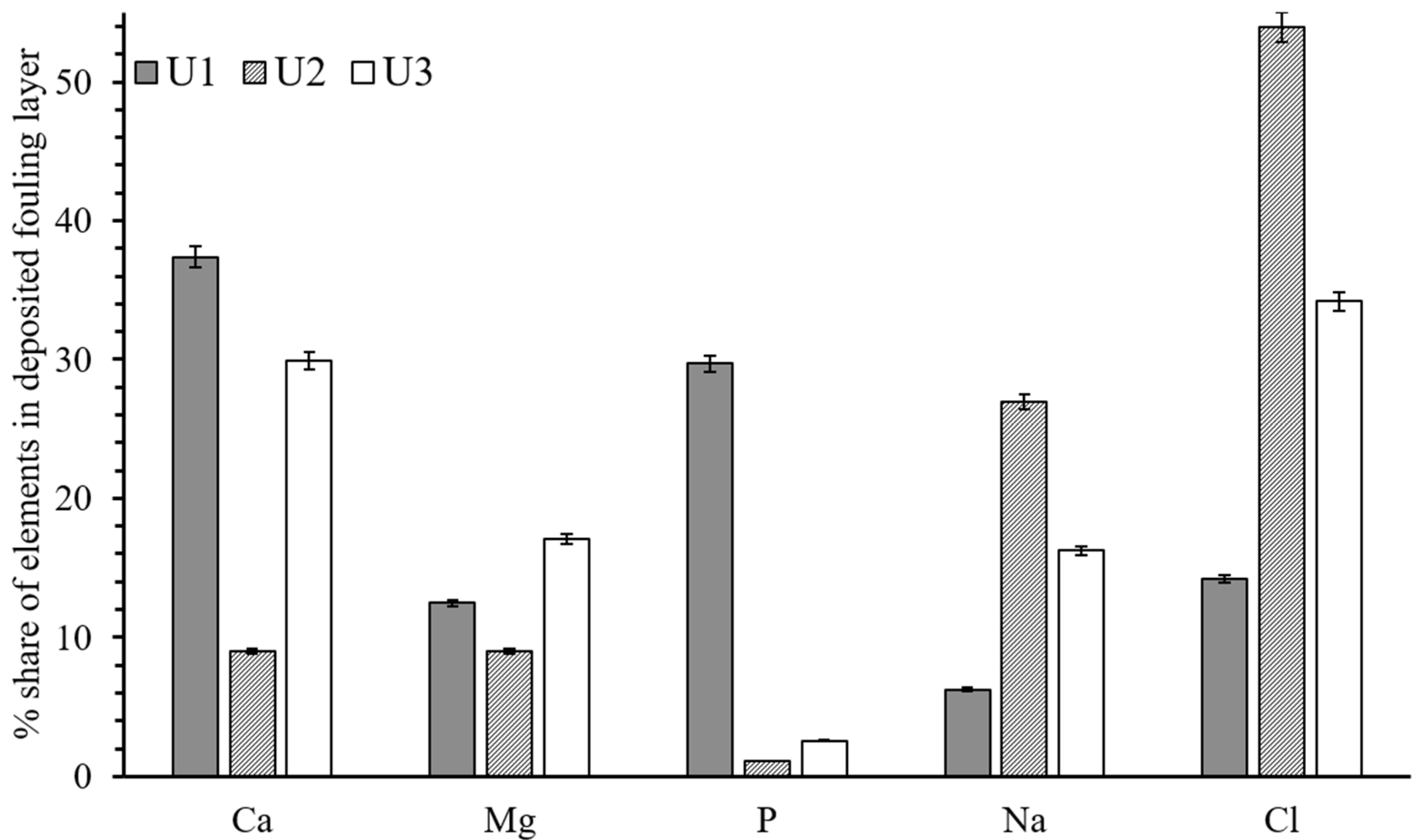
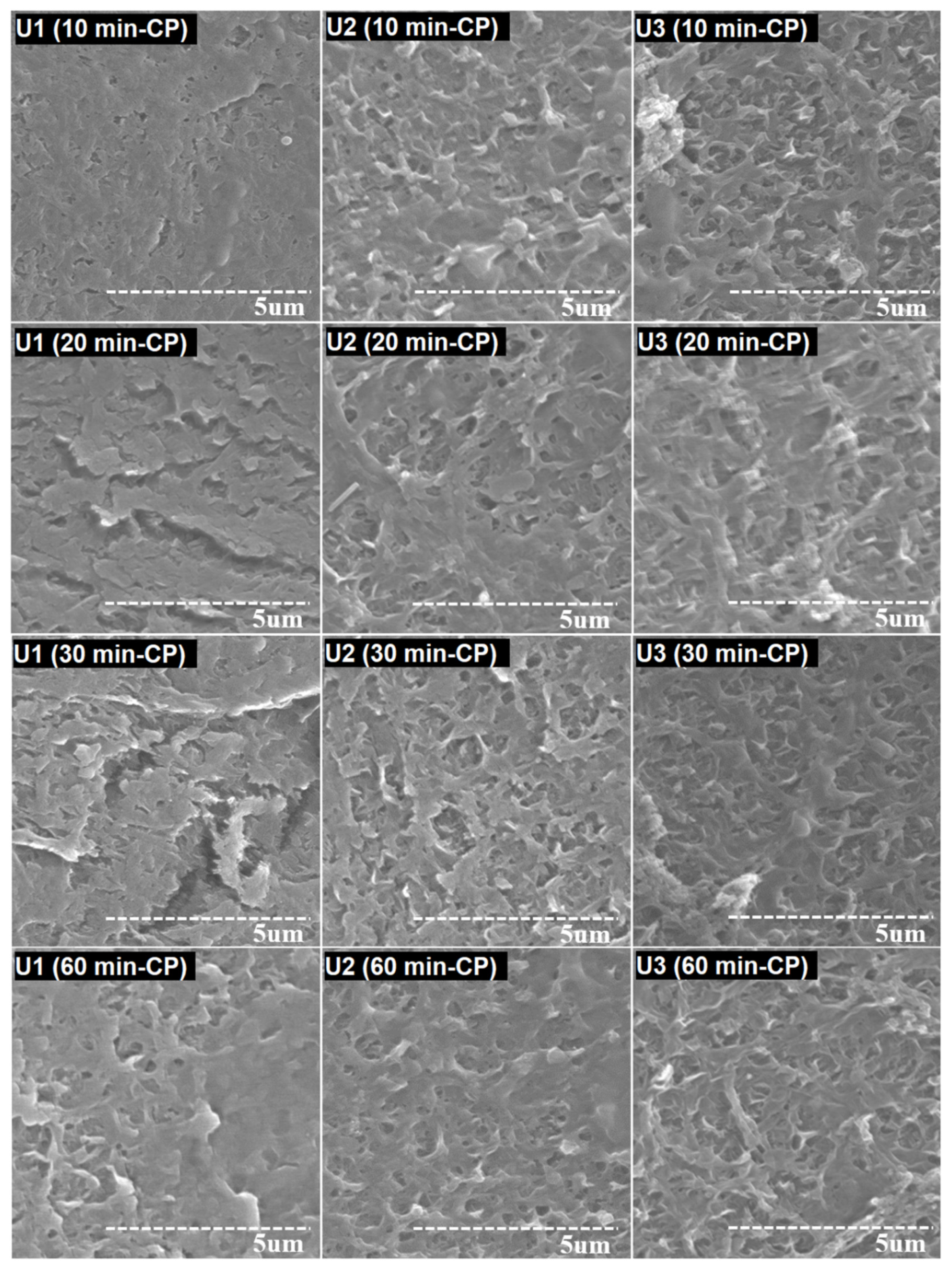

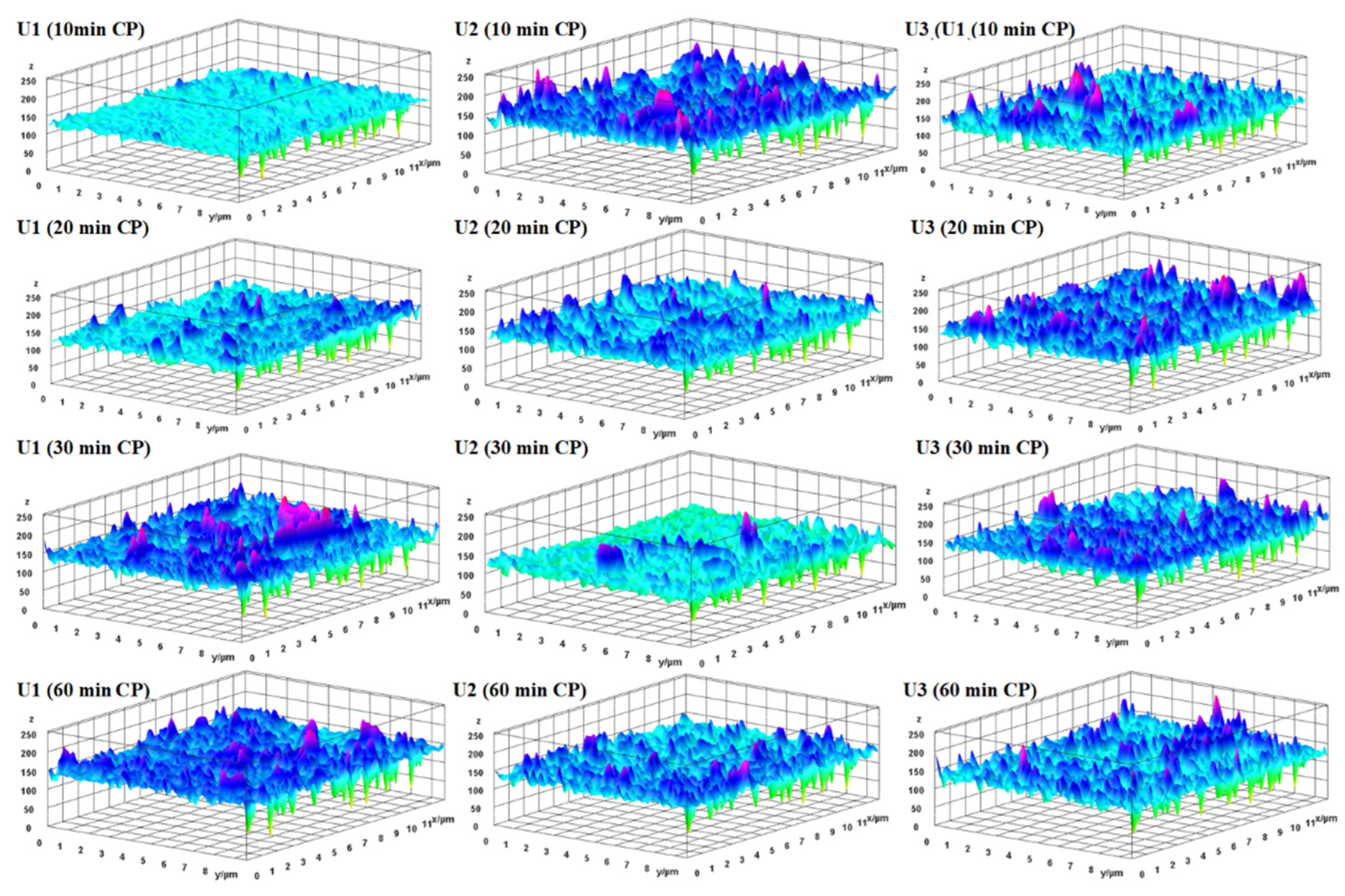
| Parameter | Analytical Result |
|---|---|
| Manufacturer | HYUNDAI Wacortec, Korea |
| Membrane material | Polyamide |
| Membrane configuration | Spiral-wound thin-film composite |
| Membrane area | 0.4 m2 |
| MWCO | ~100 Da. |
| Permeate flowrate | 50 GPD |
| Maximum operating temperature | 113 °F |
| Maximum operating pressure | 8.6 bar |
| Maximum feed flow rate | 7.6 L/min |
| pH operating range | 3–10 |
| Membrane | After Operation | After 10 min CP | After 20 min CP | After 30 min CP | After 60 min CP |
|---|---|---|---|---|---|
| U1 | 124.3 | 127.7 | 132.9 | 143.9 | 147.7 |
| U2 | 133.1 | 142.9 | 135.0 | 142.0 | 137.1 |
| U3 | 127.4 | 133.0 | 142.9 | 120.9 | 134.9 |
Publisher’s Note: MDPI stays neutral with regard to jurisdictional claims in published maps and institutional affiliations. |
© 2022 by the authors. Licensee MDPI, Basel, Switzerland. This article is an open access article distributed under the terms and conditions of the Creative Commons Attribution (CC BY) license (https://creativecommons.org/licenses/by/4.0/).
Share and Cite
Shahid, M.K.; Choi, Y. CO2 as an Alternative to Traditional Antiscalants in Pressure-Driven Membrane Processes: An Experimental Study of Lab-Scale Operation and Cleaning Strategies. Membranes 2022, 12, 918. https://doi.org/10.3390/membranes12100918
Shahid MK, Choi Y. CO2 as an Alternative to Traditional Antiscalants in Pressure-Driven Membrane Processes: An Experimental Study of Lab-Scale Operation and Cleaning Strategies. Membranes. 2022; 12(10):918. https://doi.org/10.3390/membranes12100918
Chicago/Turabian StyleShahid, Muhammad Kashif, and Younggyun Choi. 2022. "CO2 as an Alternative to Traditional Antiscalants in Pressure-Driven Membrane Processes: An Experimental Study of Lab-Scale Operation and Cleaning Strategies" Membranes 12, no. 10: 918. https://doi.org/10.3390/membranes12100918






